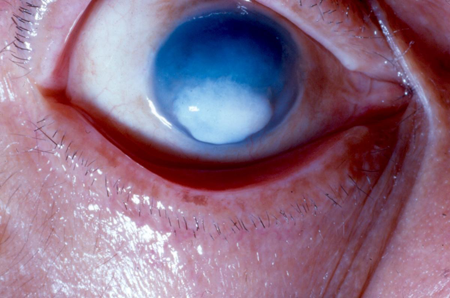Management after ocular trauma in children is often challenging due to difficulty in assessment, extensive postoperative inflammation, and occlusion amblyopia. After ocular injuries, irregular astigmatism and surgical aphakia are the 2 principal refractive complications.1
Irregular astigmatism is usually a consequence of corneal scarring, and treatment includes rigid gas-permeable (RGP) contact lenses, corneal transplants, or phototherapeutic keratectomy. Managing children who undergo keratoplasties is challenging because they have to undergo frequent exams under anesthesia and also because they suffer from graft failure, astigmatism, and amblyopia.2 The advantage of penetrating keratoplasty is that it can be used to treat a wide spectrum of corneal scars including leucomas.3
Excimer laser phototherapeutic keratectomy is another method used to treat corneal scars. The superficial corneal opacities and irregularities are removed with a 193‑nm ultraviolet light. Advantages to the procedure are that it is less invasive than keratoplasty and it does not require long-term compliance of contact lenses.7–9 Disadvantages are that it is not suitable for deep corneal stromal scars and it often results in post-treatment ametropia, requiring optical correction.7–8,10
RGP contact lenses are a less-invasive alternative to surgery in the visual rehabilitation of penetrating trauma.3 The advantages of using contact lenses include the ability to negate irregular astigmatism and the minimizing of anisometropia and aniseikonia in the treatment of unilateral aphakia. RGP lenses also have a high oxygen permeability and low bacterial and protein adherence.4–6
Unilateral aphakia can be treated by contact lenses or intraocular lens implants. Surgical treatment in these cases can be challenging because the original trauma often compromises the capsular bag, requiring the surgeon to fixate the IOL with suture during the procedure. Sutured IOLs also carry the risk of dislocation, tilt, secondary glaucoma, and suture exposure.4
A study by Guyton identified the magnitude of astigmatism as a relevant factor affecting visual outcome.11 Eyes with higher astigmatism (> 5.00 D as measured with a keratometer or topographer) had better visual improvement with contact lenses than those with less astigmatism.3 The authors hypothesize that introducing the cylinder into spectacles causes meridional magnification, monocular distortion, and alteration of binocular spatial perception. The use of contact lenses reduces the vertex distance to zero, helping to eliminate the distortion to create a clear retinal image.11
Regardless of the management provided, patience and good communication between the physician and the patient are essential to create satisfactory outcomes.12

Figure 1. Corneal scar after trauma.
References
- Jandeck C, Kellner U, Bornfeld N, et al. Open globe injuries in children. Graefes Arch Clin Exp Ophthalmol. 2000;238:420–426.
- Vanathi M, Panda A, Vengayil S, et al. Pediatric keratoplasty. Surv Ophthalmol. 2009;54:245–271.
- Pradhan ZS, Mittal R, Jacob P. Rigid Gas-Permeable Contact Lenses for Visual Rehabilitation of Traumatized Eyes in Children. Cornea. 2014. 33(5):486-489.
- Luo W, Tong JP, Shen Y. Rigid gas-permeable contact lens for visual rehabilitation in aphakia following trauma. Clin Exp Optom. 2012;95:499–505
- Galindo-Ferreiro A, Galindo-Alonso J, Sánchez-Tochino H, et al. Contact lens fitting in 133 eyes with irregular astigmatism [in Spanish]. Arch Soc Esp Oftalmol. 2007;82:747–751.
- Shaughnessy MP, Ellis FJ, Jeffery AR, et al. Rigid gas-permeable contact lenses are a safe and effective means of treating refractive abnormalities in the pediatric population. CLAO J. 2001;27:195–201.
- Campos M, Nielsen S, Szerenyi K, et al. Clinical follow-up of phototherapeutic keratectomy for treatment of corneal opacities. Am J Ophthalmol. 1993;115:433–440.
- Rao SK, Fogla R, Seethalakshmi G, et al. Excimer laser phototherapeutic keratectomy: indications, results and its role in the Indian scenario. Indian J Ophthalmol. 1999;47:167–172.
- Kollias AN, Spitzlberger GM, Thurau S, et al. Phototherapeutic keratectomy in children. J Refract Surg. 2007;23:703–708.
- Alió JL, Belda JI, Shalaby AM. Correction of irregular astigmatism with excimer laser assisted by sodium hyaluronate. Ophthalmology. 2001;108:1246–1260.
- Guyton DL. Prescribing cylinders: the problem of distortion. Surv Ophthalmol. 1977;22:177–188.
- Jurkus JM. Contact lenses for children. Optom Clin. 1996;5:91–104.